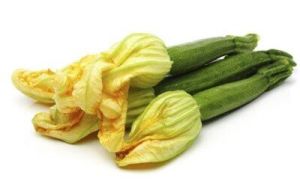
Zucchini Flowers
Zucchini is a member of the the squash and pumpkin or cucurbita family of vegetables. Good-quality zucchini should be firm, smooth-skinned and small in size. The surface will be shiny and dark-green / yellow in color. Nutritional Facts It contains useful amounts of many vitamins and minerals and few calories. Medicinal / Therapeutic Use Zucchini is good to use where there are problems with high blood pressure, constipation, obesity and for bladder and kidney afflictions.
...more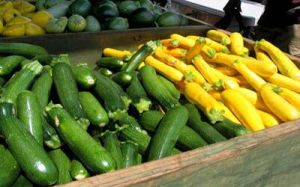
Yellow Zucchini
Zucchini is a member of the the squash and pumpkin or cucurbita family of vegetables. Good-quality zucchini should be firm, smooth-skinned and small in size. The surface will be shiny and dark-green / yellow in color. Nutritional Facts It contains useful amounts of many vitamins and minerals and few calories.
...more
Yellow Capsicum
Capsicums are seed pods and can be red, green, yellow, orange, white or purple. Green and red capsicums grow on the same plant; it's just that a red pepper is a ripe green one. Yellow, orange, white and purple are different varieties and are not simply less ripe forms of red or green. Capsicums are sweet and juicy with a mild spicy flavour. Shape also varies with variety; from the more commonly found blocky shape to a pointy capsicum.
...more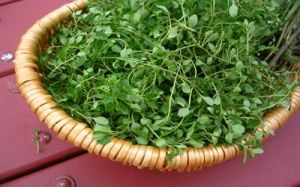
Thyme Leaves
It is a small, bushy herb, its stems 6 to 8 inches high, branching at the base, slender and leafy. Nutritional Facts Externally, its use has been recommended as an addition to warm baths, especially for children, as a strengthener and nerve soother. The oil, which is very heating, is of service as a rubefacient, applied to the skin in sciatica and neuralgia. One drop of the oil, on cotton wool, put into a decayed tooth, will alleviate the pain. The flowering thyme tops contain an essential oil consisting primarily of thymol and carvacrol, along with tannins, bitter compounds, saponins, and organic acids. These are used to flavour jugged hare, etc., they have a milder and rather more grateful flavour. Medicinal / Therapeutic Use Externally, it can be used as an addition to warm baths, especially for children, as a strengthener and nerve soother. The oil, which is very heating, is of service as a rubefacient, applied to the skin in sciatica and neuralgia. One drop of the oil, on cotton wool, put into a decayed tooth, will alleviate the pain. The flowering tops are used to flavour jugged hare; they have a milder and rather more grateful flavour.
...more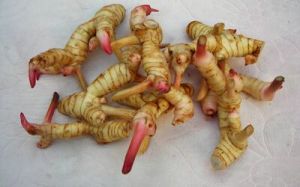
Thai Galangal
Galangal is a rhizome that is related to and resembles ginger, but has a mildly mustardlike, slightly medicinal taste; ginger is not an acceptable substitute. It is sold both whole fresh and as dried slices; halve the quantity when using dried. Galangal is also called Siamese ginger, kha in Thailand, and lengkuas or laos in Indonesia and Malaysia. Nutritional Facts It is a good source of dietary fibre and vitamin B1. It has no cholesterol. Medicinal / Therapeutic Use Asian medicine known to treat diarrhoea and vomiting.
...more
Sweet Basil Thai
The shortly - stalked, egg shaped leaves, 1 to 2 inches long, are placed opposite to one another on the four-angled stem, the pairs being some distance apart. They are only slightly toothed at their edges and like the stem are downy with soft hairs. Nutritional Facts It is rich in calcium, phosphorus, Vitamin A and C . Medicinal / Therapeutic Use Basil is antispasmodic, relieves or eases muscular spasms, cramps or convulsions; aromatic, having an agreeable odor and stimulating qualities; carminative, easing griping pains, colic and expelling gas from the intestines; galactagogue, encourages or increases the secretion of milk; refrigerant, lowers abnormal body heat, relieves thirst and gives a feeling of coolness; stomachic, strengthens, stimulates or tones the stomach; vermifuge, helps in expelling parasitic worms, especially of the intestines.
...more
Snow Peas
The pods of snow peas are flat and thin with the bulge of the tiny seed barely visible at prime eating stage. The bright green pods should be turgid and crisp. They contain five to seven seeds and reach a length of two to three inches. The pods of sugar snaps are plump like regular English peas but are sweet and tender, thus eaten whole without being shelled, eaten raw or cooked. Nutritional Facts Snow peas provide vitamins A and C, iron and potassium. They are low in sodium. A 3 ounce serving, cooked and drained, contains 43 calories. Medicinal / Therapeutic Use Peas contain a chemical that helps to prevent infection of the appendix wall. Like other legumes, peas are high in purines, which can exacerbate gout in people and birds with this disease.
...more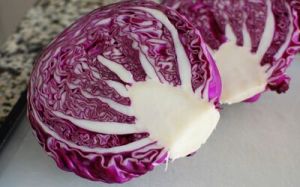
Red Cabbage
The Red Cabbage leaves are coloured dark mauve. However, the plant changes its colour according to the pH value of the soil. On acidic soils, the leaves grow more reddish while an alkaline soil will produce rather blue coloured cabbages. This explains the fact that the very same plant is known by different colours in various regions. Red Cabbage needs well fertilized soil and sufficient humidity to grow. Red Cabbage can be stored easily. This is also used as an acidic solution tester. Nutritional Facts Cabbage is high in beta-carotene, vitamin C and fiber. Medicinal / Therapeutic Use Cabbage is a cruciferous vegetable and may reduce the risk of some forms of cancer including colorectal cancers.
...more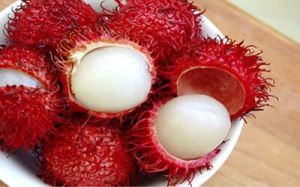
Rambutan
An attractive fruit with a bright red skin covered in green tipped hairs, the rambutan is a delicious, white fleshy fruit. Thai rambutans are particularly noted for their sweetness. The name Rambutan is derived from the Malayan word rambut which means hairs. Nutritional Facts There is usually a single light brown seed which is high in certain fats and oils (primarily oleic acid and eicosanoic acid) valuable to industry, and used in cooking and the manufacture of soap. Medicinal / Therapeutic Use Rambutan roots, bark and leaves have various uses in medicine and in the production of dyes
...more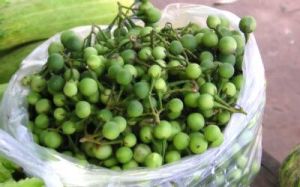
Pea Brinjal
Egg plant is also known as the aubergine. Actually a fruit, egg plants contain many fine seeds. Skin colours range from a deep purple, almost black, to a light purple with creamy streaks to all white. It has a mild taste and is typically cooked with stronger flavours such as garlic, tomatoes, onions, herbs and spices. Baby egg plants, also called Thai Stam or Pea Brinjal, are green egg plants not larger than marbles. Nutritional Facts Egg plants supply small amounts of a range of vitamins and minerals including vitamin C and B group vitamins. The purple pigment in the skin contains high levels of antioxidants called anthocyanins. Medicinal / Therapeutic Use Eggplants have a small amount of nutrients. They are naturally low in calories and unpeeled, they provide some fiber. There is also some folate and potassium.
...more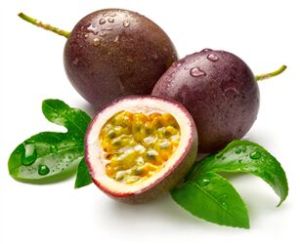
Passion Fruit
The purple passion fruit is native from southern Brazil through Paraguay to northern Argentina. The passion fruit is a vigorous, climbing vine that clings by tendrils to almost any support. It can grow 15 to 20 ft. per year once established and must have strong support. It is generally short-lived (5 to 7 years). The nearly round or ovoid fruit, 1-1/2 to 3 inches wide, has a tough rind that is smooth and waxy and ranging in hue from dark purple with faint, fine white specks, to light yellow or pumpkin-color. Within is a cavity more or less filled with an aromatic mass of double walled, membranous sacs containing orange-colored, pulpy juice and as many as 250 small, hard, dark brown or black, pitted seeds. The unique flavor is appealing, musky, guava-like and sweet / tart to tart.
...more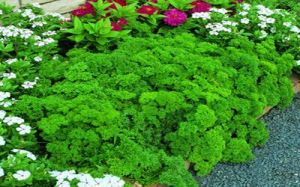
Curled Parsley Leave
An attractive curly leaved plant, parsley can grow to 60 cm in height. There are several different varieties Hamburg, French and curly (the most familiar) being among the best known. Nutritional Facts Parsley is very high in vitamin C. It is a very familiar herb, used to decorate savoury dishes. The leaves can be finely chopped for sauces and fish dishes, salads and cooked vegetables. Medicinal / Therapeutic Use Anti-cancer because of its high concentrations of antioxidants, such as monoterpenes, phthalides, polyacetylenes. Can help detoxify carcinogens and neutralize certain carcinogens in tobacco smoke. Also, has diuretic activity.
...more
Oyster Mushroom
The oyster is one of the more commonly sought wild mushrooms, though it can also be cultivated on straw and other media. The cap is smooth; oblong and often convex with age; 50-200 mm in diameter; and ranges from white to brown to blue-gray. The flesh of the most common variety is white and can be thin or thick.
...more
Oregano
Oregano is a member of the mint family. It is a spicy, Mediterranean, perennial herb, particularly common in Greek and Italian cuisines. It is the leaves that are used in cooking, and the dried herb is often more flavourful than the fresh. Aromatic, warm and slightly bitter. Oregano is high in antioxidant activity, has demonstrated antimicrobial activity against foodborned pathogens.
...more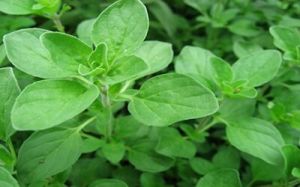
Marjoram
Marjoram is a cold-sensitive perennial herb or undershrub with sweet pine and citrus flavors. Marjoram is cultivated for its aromatic leaves, either green or dry, for culinary purposes; the tops are cut as the plants begin to flower and are dried slowly in the shade.
...more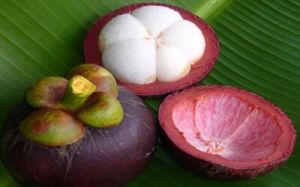
Mangosteen
Nick named the "Queen of the fruits", Mangosteens are considered one of the best tasting fruits available. Native to Malaysia and grown in South East Asia. The tree takes 12-15 years to begin to bear fruit. Considering this the fruits are expensive, but well worth the treat ! It has no relation to the mango, only the first part of its spelling. When ripe, the skin is a dark purple colour. The flesh is snow-white. It has smooth purple skin. The fruits are small and round. It tastes sweet, mildly acidic and scented. Nutritional Facts Mangosteen is high in Calcium, Phosphorous, vitamins B & C. Medicinal / Therapeutic Use To truly enjoy its unique flavour and dramatic presentation mangosteens are best served on there own.
...more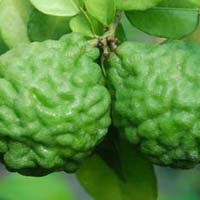
Makrut Fruit
Kaffir lime / Makrut is a small, round, gnarled variety of lime indigenous to Southeast Asia-known as Limau Perut in Malaysia and Makrut in Thailand. A kaffir lime leaf looks as if two glossy, dark green leaves were joined together end to end. The leaves and rind are used in curry pastes and other dishes as a source of intense, citrusy aroma and flavor. Nutritional Facts Like all citrus fruits, it is rich in vitamin C. Its juice is widely used in cooking. Medicinal / Therapeutic Use It has antiseptic and tonic properties, relieves rheumatism and is an excellent remineralizing agent.
...more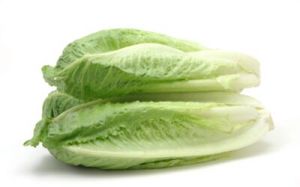
Lettuce - Romaine Green
Romaine combines good flavor and crunch, plus it has a decent shelf life in the refrigerator. It's the preferred green for Caesar salad. Green Romaine is the most common variety, but you can sometimes find Red Romaine, which is more tender. Nutritional Facts The nutritional value of lettuce varies with the variety. Lettuce in general provides small amounts of dietary fiber, some carbohydrates, a little protein and a trace of fat. Its most important nutrients are vitamin A and potassium. The vitamin A comes from beta carotene, whose yellow-orange is hidden by green chlorophyll pigments. Beta carotene, of course, is converted to vitamin A in the human body. Medicinal / Therapeutic Use According to the American Cancer Institute and the American Cancer Society, foods rich in vitamin A and C (antioxidants) offer protection against some forms of cancer. Along with other phytochemical, antioxidants reduce the risk of cancer of the respiratory system and intestinal tract.
...more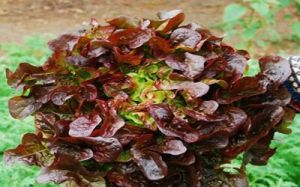
Lettuce Red Oak Leaf
A Looseleaf that produces large heads of many oak-shaped leaves which turn a deep burgundy as they mature -- grow in full sun for deepest colour. Somewhat heat resistant, this is one of the most vigorous lettuces in cooler climates. Oak Leaf has thin tender light green or brown/red leaves shaped like oak leaves, which form a rosette. It forms intensive brown/red pigmentation under cool conditions with high light intensity. Red Oak has a ruffle leaf with a fairly nut-like flavour, used in all kinds of salads. Nutritional Facts The nutritional value of lettuce varies with the variety. Lettuce in general provides small amounts of dietary fiber, some carbohydrates, a little protein and a trace of fat. Its most important nutrients are vitamin A and potassium. The vitamin A comes from beta carotene, whose yellow-orange is hidden by green chlorophyll pigments. Beta carotene, of course, is converted to vitamin A in the human body. Medicinal / Therapeutic Use It is claimed that lettuce is an excellent remedy for acid indigestion and "heartburn." The bitter, milky latex sap is a mild narcotic and sleep inducer.
...more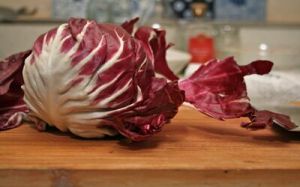
Lettuce Radicchio
Radicchio is a leaf chicory, sometimes known as Italian chicory. It is grown as a leaf vegetable which usually has white-veined red leaves. It has a bitter and spicy taste, which mellows when it is grilled or roasted. It can also be used to add color and zest to salads Nutritional Facts The nutritional value of lettuce varies with the variety. Lettuce in general provides small amounts of dietary fiber, some carbohydrates, a little protein and a trace of fat. Its most important nutrients are vitamin A and potassium. The vitamin A comes from beta carotene, whose yellow-orange is hidden by green chlorophyll pigments. Beta carotene, of course, is converted to vitamin A in the human body. Medicinal / Therapeutic Use It has good medicinal properties; is useful as a blood purifier and an aid for insomniacs. In fact, radicchio contains intybin, a blood and liver tonic.
...more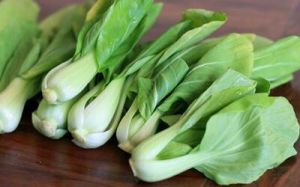
Lettuce Bok Choy
Pak Choy is a non-heading type of cabbage related to the Chard family. Varieties include Pai Tsai, Shanghai, Bok Choy, Lei Choy and Canton Pak Choi. All of these varieties can be identified by their dark green leaves and white ribs, with the exception of Shanghai varieties, which produce light green ribs and leaves. Nutritional Facts Pak choy is low in calories and a good source of vitamin A and C. A 3 ounce serving contains about 13 calories, 75 percent of the RDA for vitamin C, and 33 percent of the RDA for vitamin A. Medicinal / Therapeutic Use It contains numerous anti-cancer and antioxidant compounds. Speeds up estrogen metabolism, is thought to help block breast cancer and suppress growth of polyps, a prelude to colon cancer. Contains anti-ulcer compounds; cabbage juice helps heal ulcers in humans. Has anti-bacterial and anti-viral powers.
...more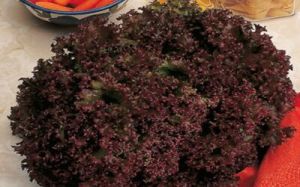
Lettuce Lollo Rosso
Lollo Rosso has a heavily ruffled leaf with a light crunchy texture with a distinctive red coloration. The red increases with stress situations, such as extreme cold or heat, which causes the natural red pigment inside the plant to become increasingly dominant. It can be used in all kinds of salads and garnishes. Nutritional Facts The nutritional value of lettuce varies with the variety. Lettuce in general provides small amounts of dietary fiber, some carbohydrates, a little protein and a trace of fat. Its most important nutrients are vitamin A and potassium. The vitamin A comes from beta carotene, whose yellow-orange is hidden by green chlorophyll pigments. Beta carotene, of course, is converted to vitamin A in the human body. The darker green, the more beta carotene. Medicinal / Therapeutic Use According to the American Cancer Institute and the American Cancer Society, foods rich in vitamin A and C (antioxidants) offer protection against some forms of cancer. Along with other phytochemical, antioxidants reduce the risk of cancer of the respiratory system and intestinal tract.
...more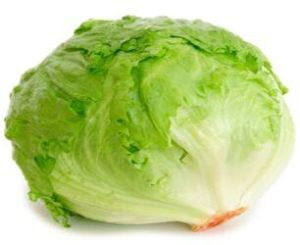
lettuce iceberg
Lettuce in general provides small amounts of dietary fiber, some carbohydrates, a little protein and a trace of fat. Its most important nutrients are vitamin A and potassium. According to the American Cancer Institute and the American Cancer Society, foods rich in vitamin A and C (antioxidants) offer protection against some forms of cancer. Along with other phytochemical, antioxidants reduce the risk of cancer of the respiratory system and intestinal tract.
...more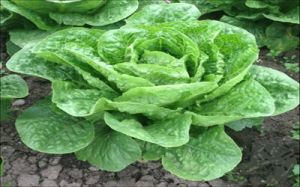
Cos Lettuce
Cos lettuce is a variety of lettuce which grows in a long head of sturdy leaves with a firm rib down the center. Unlike most lettuces, it is tolerant of heat. Cos lettuce develops into an elongated, somewhat oval shaped head. Leaves are elongated, with thick stems and mid-ribs. Heads are only medium firm, and up to 9 or 10 inches in length. Outer leaves, which are largely discarded, enfold the head during late stages of growth. Nutritional Facts The nutritional value of lettuce varies with the variety. Lettuce in general provides small amounts of dietary fiber, some carbohydrates, a little protein and a trace of fat. Its most important nutrients are vitamin A and potassium. The vitamin A comes from beta carotene, whose yellow-orange is hidden by green chlorophyll pigments. Beta carotene, of course, is converted to vitamin A in the human body. Medicinal / Therapeutic Use According to the American Cancer Institute and the American Cancer Society, foods rich in vitamin A and C (antioxidants) offer protection against some forms of cancer. Along with other phytochemical, antioxidants reduce the risk of cancer of the respiratory system and intestinal tract.
...moreBe first to Rate
Rate ThisOpening Hours